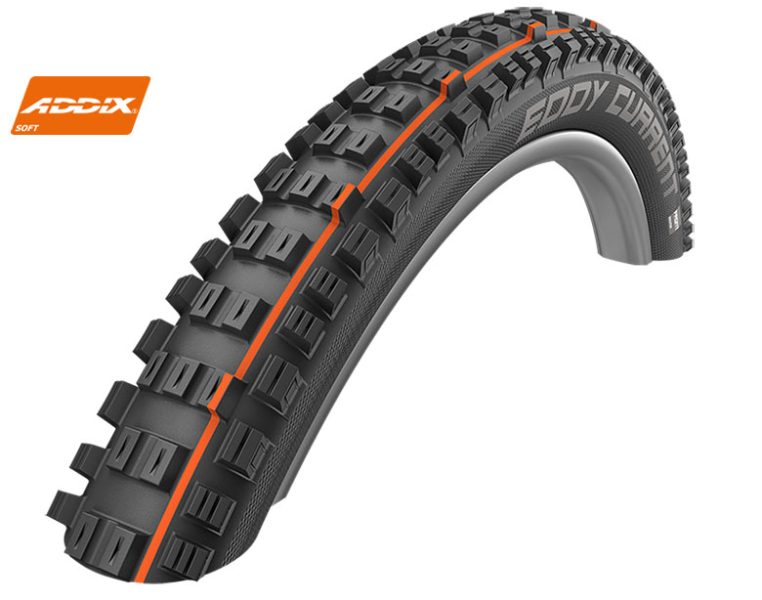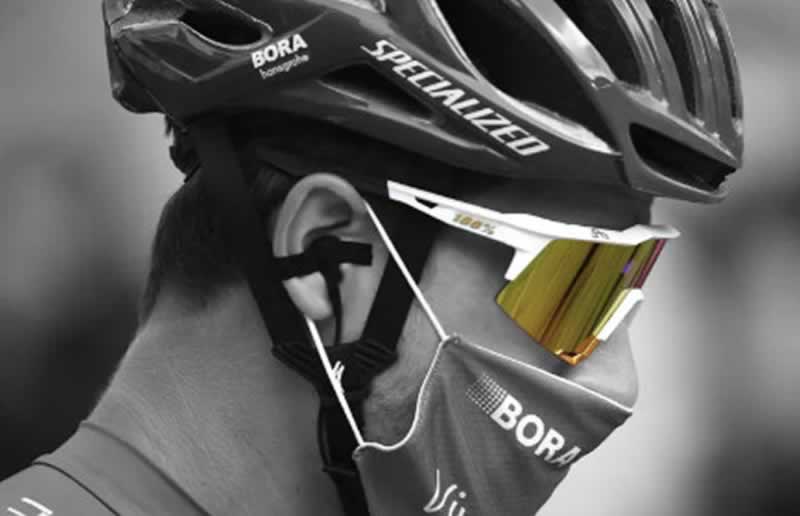
Choosing the Perfect Photochromic Mountain Biking Eyewear (2021)
Content
- Vision, how does it work?
- Why use goggles on mountain bikes?
- Photochromic lenses
- What criteria should be considered when choosing good mountain bike goggles?
- Products
- Julbo: supremely responsive
- AZR: Value for money
- Rudy Project: an unbreakable guarantee 🔨!
- CAIRN: Branches Refinement
- UVEX: The Pros of Professional Protection
- Bollé: Chronoshield and Phantom goggles
- What are the alternatives to photochromic lenses?
- Naked Optics: glasses and mask
- What if you need an acute optical correction?
- Conclusion
Have you ever tried mountain biking without glasses? 🙄
After a while, we realize that this is an irreplaceable accessory, just like a helmet or gloves.
We'll tell you (a lot) more in this file to find the best sunglasses with the ideal technology for mountain biking: lenses that adapt to brightness (photochromic).
Vision, how does it work?
Yes, we will still go through a little theoretical phase to fully understand the interests of protecting your eyes and especially how to do it.
Before we talk about mountain biking goggles, we need to talk about vision and therefore the organ responsible for it: the eye.

When you see something, it looks like this:
- Your eye catches a stream of light.
- Iris regulates this flow of light by adjusting the diameter of your pupil, just like a diaphragm. If the pupil receives a lot of light, it is small. If the pupil receives little light (dark place, night), it dilates so that as much light as possible enters the eye. This is why, after a little adaptation time, you can navigate in the dark.
- Light particles or photons travel through the lens and vitreous before reaching the light-sensitive cells (photoreceptors) of the retina.
There are two types of photoreceptor cells.
- "Cones" are responsible for color vision, for detail, they provide good vision in the center of the field of view. Cones are often associated with daytime vision: daytime vision.
- Rods are much more sensitive to light than cones. They provide photographic vision (very low light).
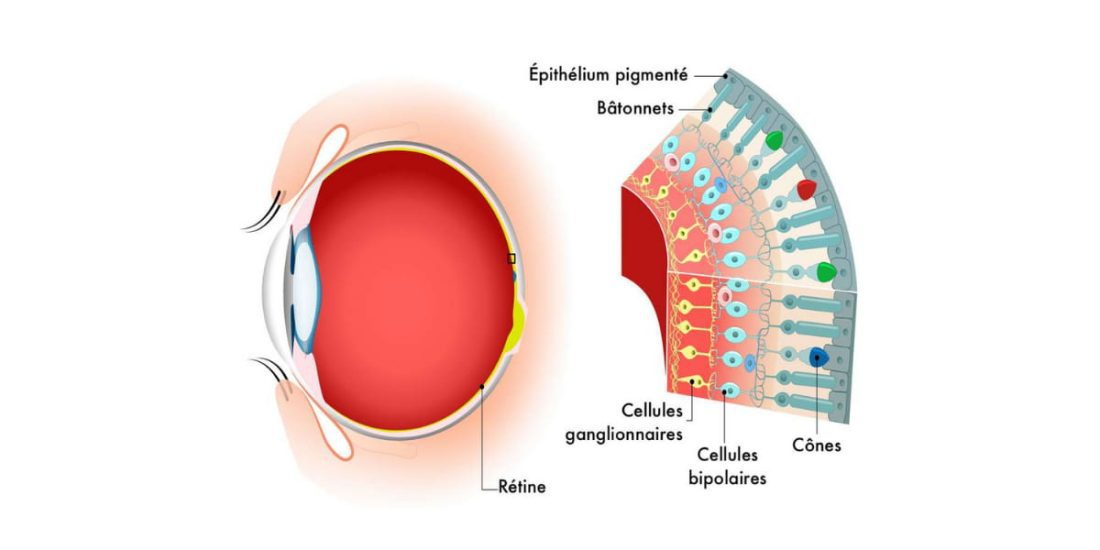
Your retina and its photoreceptors convert the light it receives into electrical impulses. This nerve impulse is transmitted to the brain via the optic nerve. And there your brain can do its job translating all of this.
Why use goggles on mountain bikes?

Protect your eyes from injury
Branches, thorns, twigs, gravel, pollen, dust, zoometeors (insects) are very common in nature when you are mountain biking. And an easy way to protect your eyes from injury is to put them behind a shield, but a shield that doesn't obstruct your vision: sports glasses. Forget your MTB goggles one day and you will see that your eyes are not sparing!
Bicycle goggles, lightweight and adapted to face morphology, are not felt and protect.
Beware of fog, which can cause discomfort in the event of stress or heatstroke. Some lenses are anti-fog treated or shaped to allow air to pass through and prevent fogging.
Protect your eyes from dry eye syndrome
The eyes are lubricated, as are all the mucous membranes of the body. If the mucous membranes dry out, they become painful and can quickly become infected.
The eye is smeared with a film consisting of three layers:
- The outermost layer is oily and reduces evaporation. Produced by the meibomian glands located along the edges of the eyelids,
- The middle layer is water, it also performs a cleansing function. It is produced by the lacrimal glands located under the eyebrow, just above the eye, and by the conjunctiva, the protective membrane that lines the inside of the eyelids and the outside of the sclera.
- The deepest layer is the mucus layer, which allows tears to stick and spread evenly over the surface of the eye. This layer is produced by other small glands in the conjunctiva.
On a bicycle, speed creates a relative wind that acts on this lubrication system. The grease evaporates and the seals no longer produce enough grease. Then we get dry eye syndrome, and at this time, another type of gland, the lacrimal glands, takes over and secretes tears: that's why you cry when it's windy, or when you walk (very) fast.
And tears on a bike are embarrassing, because they blur the vision.
By shielding the eyes from airflow with MTB goggles, the eye does not dry out and no longer has a reason to produce tears that could impair vision.
We arrive at the paradox of fog, which can only disappear if it evaporates. Therefore, glasses must be protected from the wind, preventing fogging. This is where the ingenuity of manufacturers comes into play and the combination of lens processing and frame design is a fine balance to be found. That's why cycling goggles have concave lenses that optimize airflow.
In fact, on mountain bikes, you should ALWAYS wear goggles (or a mask for DH or Enduro) to protect your eyes.
Protect your eyes from UV rays
The light emitted by the sun is beneficial so that we can see correctly and carry out our activities.
Natural light consists of a spectrum of waves, some of which are invisible to the human eye, such as ultraviolet and infrared. Ultraviolet rays can damage very sensitive structures in the eye, such as the lens. And over time, these lesions increase the risk of diseases affecting vision.
UV types A and B are the most dangerous for eyesight. Therefore, we will try to take glasses that filter almost everything.
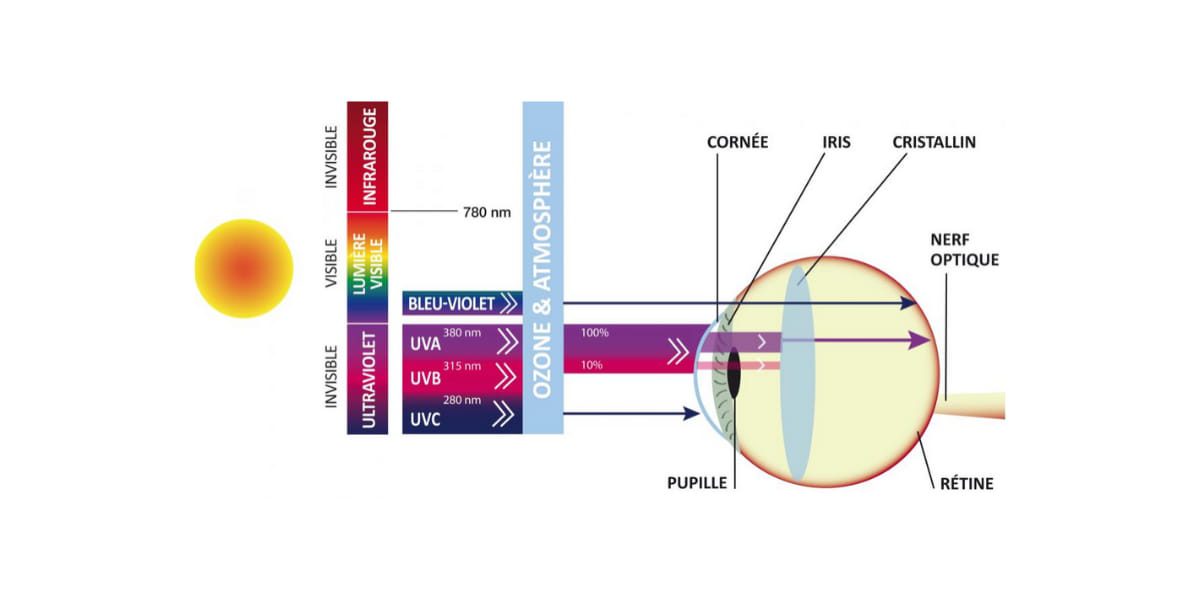
The color of the glasses does not indicate their filtering properties.
The difference is fundamental: the shade protects against glare, the filter - from burns due to UV rays. Clear/neutral lenses can filter out 100% of UV rays, while dark lenses can let in too much UV.
So be careful when choosing, make sure the CE UV 400 standard is present on your pair of sunglasses.
According to the AFNOR NF EN ISO 12312-1 2013 standard for sunglasses, there are five categories, classified on a scale from 0 to 4, depending on the increase in the percentage of filtered light:
- Category 0 associated with the cloud symbol does not protect against UV rays from the sun; it is reserved for comfort and aesthetics,
- Categories 1 and 2 are suitable for dim to moderate sun brightness. Category 1 is associated with the cloud symbol partially hiding the sun. Category 2 is associated with a cloudless sun, consisting of 8 rays,
- Only categories 3 or 4 are suitable for situations of strong or exceptional sunlight (sea, mountains). Category 3 is associated with the symbol of an intense sun with 16 rays. Category 4 is associated with the sun, which dominates two mountain peaks and two wave lines. Road traffic is prohibited and is symbolized by a crossed-out vehicle.
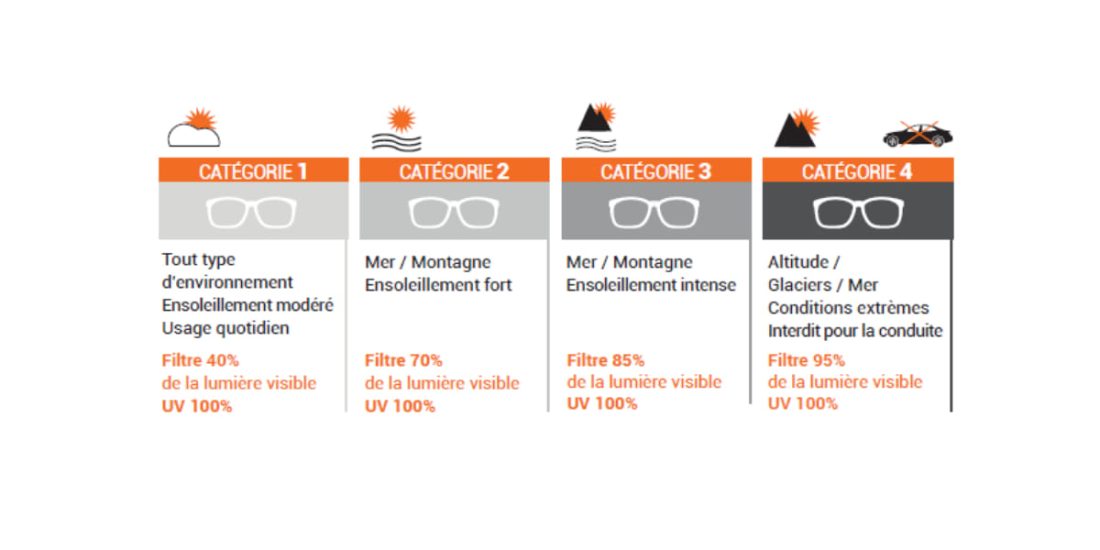
Photochromic lenses
Photochromic lenses are also called tint lenses: their tint changes depending on the resulting brightness.
In this way, photochromic lenses adapt to the lighting conditions: on the inside they are transparent, and on the outside, when they are exposed to UV rays (even in the absence of sunlight), they darken in accordance with the received UV dose.
Photochromic lenses are initially clear lenses that darken when exposed to ultraviolet light.
However, the rate of color change depends on the ambient temperature: the hotter, the less dark the glasses.
Therefore, it is recommended to use photochromic mountain bike goggles when there is little light and not too hot.
It is clear that if you plan to cross the Atlas in Morocco in June, leave your photochromic glasses at home and bring your bike sunglasses with Grade 3 or 4 lenses depending on your sensitivity.
Photochromic lenses generally fall into 3 categories. Glasses from 0 to 3 are perfect for walking at the end of the day, because when daylight fades, they turn into shadeless glasses. When you go outside in the middle of the day, glasses from 1 to 3 categories are preferred, which may turn out to be faster when changing lighting conditions. Please note that points from categories 0 to 4 do not exist (yet), this is the Holy Grail of 🏆 manufacturers.
Photochromia, how does it work?
This is achieved by processing the glass, which creates a light-sensitive layer.
On synthetic lenses (such as polycarbonate), which are used for spectacles designed for outdoor activities, a layer of oxazine is applied on one side. Under UV radiation, the bonds in the molecules are broken, and the glass darkens.
Bonds are reestablished when UV radiation disappears, which returns the glass to its original transparency.
Today, good photochromic lenses take a maximum of 30 seconds to darken and 2 minutes to clear again.
What criteria should be considered when choosing good mountain bike goggles?
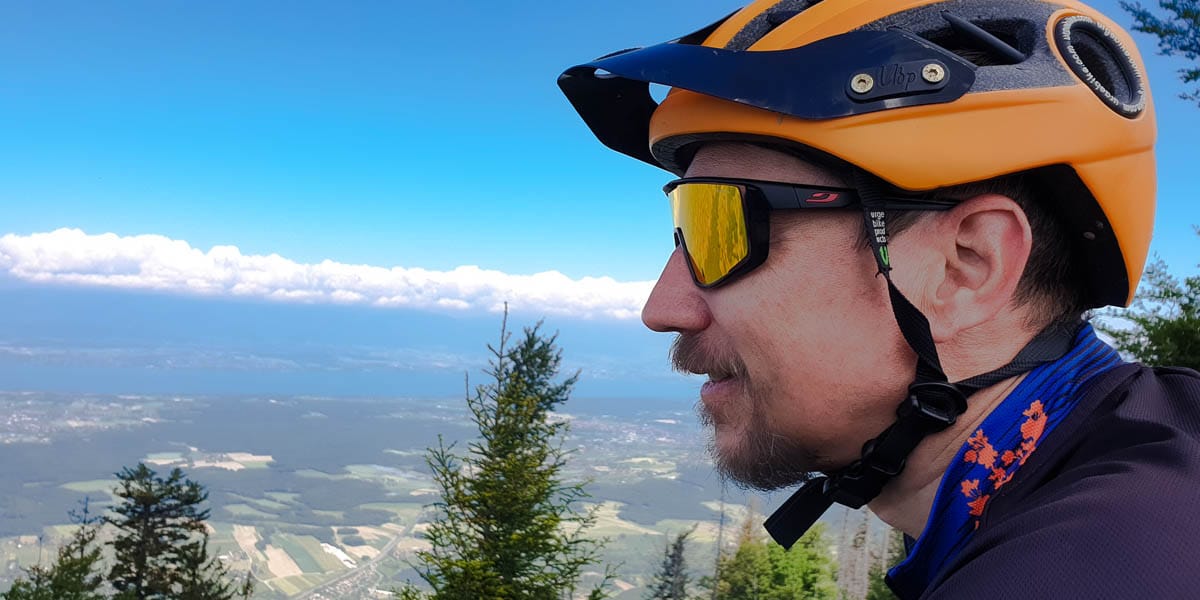
Frame
- Anti-allergenic frame, lightweight yet durable. The frame should be in proportion to your face for good support,
- Comfort on the face, especially the size and flexibility of the branches and supports on the nose,
- The shape and size of aerodynamic lenses to protect from wind and not take harmful UV rays from the sides,
- Stability: in case of vibration, the frame must remain in place and not move,
- Placement under a bicycle helmet: good for thin branches.
Points
- Ability to block 99 to 100% of UVA and UVB rays using the UV 400 standard,
- Lens filtration category and photochromic filtration rate of change, so as not to see when the light intensity changes,
- Lenses that provide a good view without distortion,
- The cleanliness of the glasses
- Anti-scratch, anti-fouling and anti-fog treatment,
- Shade of glasses: When mountain biking, we prefer glasses. bronze-brown-red-pink to enhance the color in the underbrush,
- The ability of glasses to enhance contrast: useful for viewing obstacles on the ground.
In general, before the choice
The aesthetics of frames and lenses (iridium coated lenses such as Ponch 👮 in CHIPS) and the tan marks they will leave behind,
- Color, to match the socks,
- Total weight, they should not be felt when playing sports and in particular when cycling,
- Price.
Either way, try on the frames to make sure they fit your face. And if possible, try them on with your helmet, or better yet, on a mountain bike ride. Finally, a high price tag does not mean the best protection, but often marketing placement, aesthetics and a manufacturer who reimburses their research and development costs in order to release an innovative product.
Products
Suppliers are willing to use marketing and packaging arguments and use their differences to stand out from the crowd.
An overview of the major players in the mountain biking photochromic eyewear market.
Scicon Aerotech: tuning at the limit
Italian manufacturer Scicon, better known for its bicycle accessories such as suitcases, recently decided to enter the bicycle eyewear market.
To do this, he relied on his years of presence in the bicycle market. Thanks to a successful partnership with glass blower Essilor, he has produced a wonderful and highly successful product.
The glasses are delivered in a carbon box with the most beautiful effect. When you get the product and unbox it, it's a bit of a wow effect. Aside from the glasses, there are plenty of small accessories, including a small bottle of cleaning agent, a key screwdriver, which you don't expect with glasses.
The frames are made of polyamide, lightweight and durable. Customizable, there are dozens of possible configurations:
- Flexible earpieces for improved comfort and support behind the ears
- removable clamps to stiffen the branches at the temples;
- three types of nose wedges (large, medium, small);
- Wing inserts that run under the lenses to further protect against wind in road or high-speed mode.
The fact that the frame is so customizable is a little confusing at first, but after a few tries we find the perfect fit for his face and maintain a comfortable field of view.
Their MTB goggles adhere very well to the face, covering their eyes and protecting them. On a bicycle, they are light and weight is not felt; they are comfortable and have a very wide field of view. No fogging problems, offering optimal wind protection and flawless glass quality. The quality of the Essilor NXT glass is excellent. For mountain biking, the bronze tinted lens version is recommended. Photochromia ranges from category 1 to 3 with superior clarity and contrast enhancement. The dimming and lightening kinematics are good and work well for mountain biking.
An excellent quality product with very high positioning that will be reserved for those who can pay the price as the brand has chosen to be positioned at a premium price.
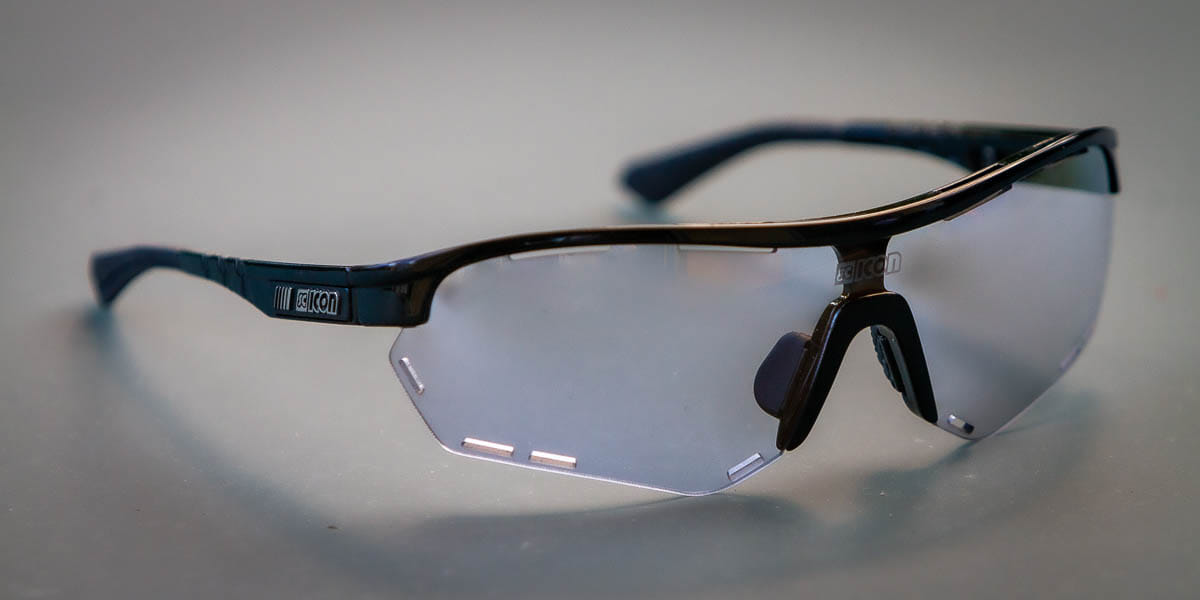
Julbo: supremely responsive
Julbo offers a model of photochromic glasses based on lenses called REACTIV photochromic.
For mountain biking, 2 models are especially interesting:
- FURY with REACTIV Performance 0-3 lens

- ULTIMATE with REACTIV Performance 0-3 lens (developed in collaboration with Martin Fourcade)
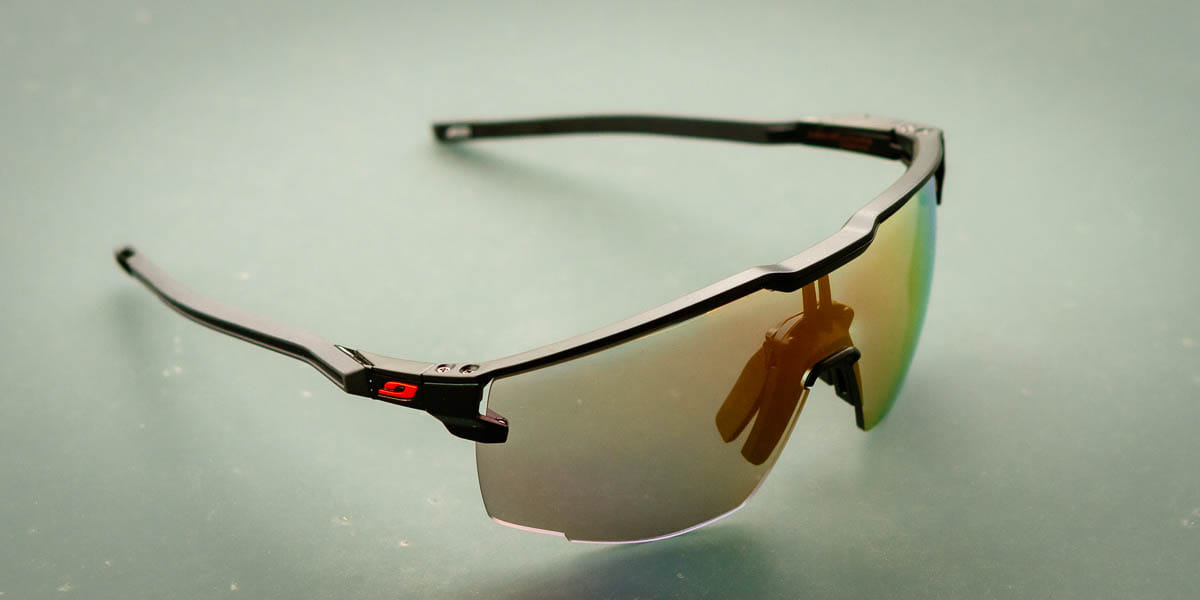
Julbo is actively promoting its REACTIV technology, photochromic lenses with anti-fog treatment and oleophobic treatment (outer surface) against contamination.
Two frames cover the image well and are comfortable to wear: the sun's rays do not pass on the sides and top, perfect support and lightness.
The lenses are large and the REACTIV technology delivers on its promise, the brightness-dependent color change is automatic and vision is not affected by dimming or inappropriate lighting.
Julbo glasses are really comfortable to use and in our tests turned out to be one of the best 😍.
Both models are very good at protecting the eyes from air currents during fast sections on the bike; We especially liked the Ultimate, with its original frame and side vents for a distortion-free panoramic view. Frame stability is excellent and the glasses are lightweight.
AZR: Value for money

A French company that specializes in cycling goggles based in Drome. AZR offers several models of goggles suitable for mountain biking with a very good value for money.
The lenses are made of polycarbonate to ensure resistance to breakage and impact, they filter 100% UVA, UVB and UVC rays and are designed to suppress prismatic distortion. Interesting characteristics and differences compared to other actors, glasses have a category from 0 (transparent) to 3, that is, a range of 4 categories.
The airflow protection is well controlled and the field of view is panoramic.
The frames are made of grilamid, a material that is elastic and deformable and offers an anti-skid system that is very comfortable to use. The branches adjust well and the spout is in good condition.
Each frame is equipped with a system for changing the screen and, for those who wear the corrector, for inserting optical lenses adapted to the scope.
We had the opportunity to test the following goggles suitable for mountain biking:
- KROMIC ATTACK RX - Colorless photochromic lens category 0 to 3
- KROMIC IZOARD - Colorless Cat Photochromic Lens 0 to 3
- KROMIC TRACK 4 RX - Colorless photochromic lens category 0 to 3
For each frame, the optical quality of photochromic screens is good, there is no distortion, and the color changes quickly. The manufacturer decided to do without the anti-fogging treatment of the lenses and relies on its ventilation system within the framework: a good bet, no fogging was formed during the tests.
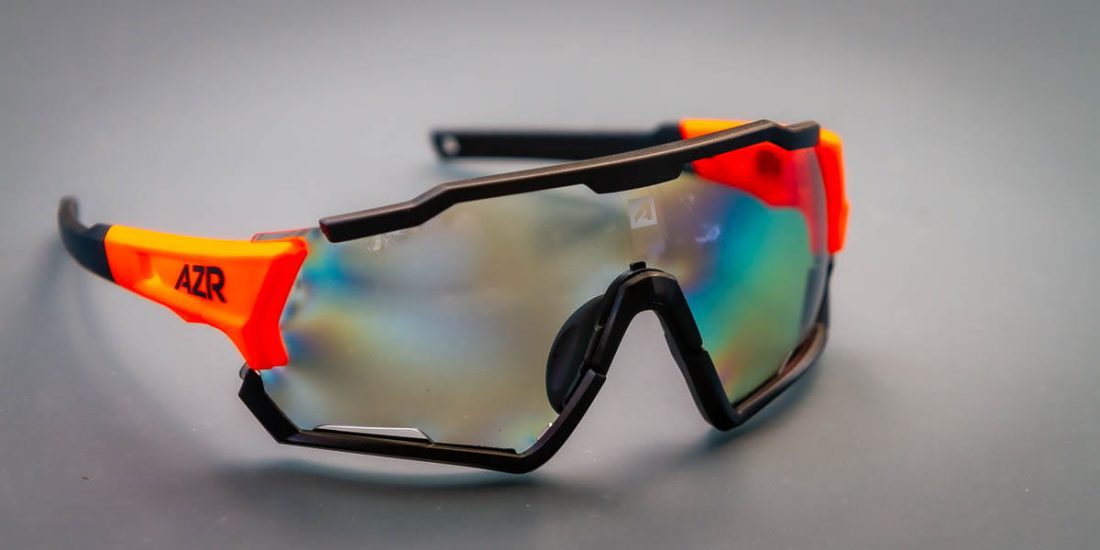
The KROMIC TRACK 4 RX model is more extensive and offers flawless eye protection from airflow, on the other hand, we are less prone to aesthetics if it is too heavy (very wide branches) than the KROMIC ATTACK RX model, which is lighter.
The KROMIC IZOARD is smaller and is primarily intended for thin faces of women and teenagers. The frame is sporty but less typical for cycling than other models. This is a good reason for the "gender" definition of the AZR range.
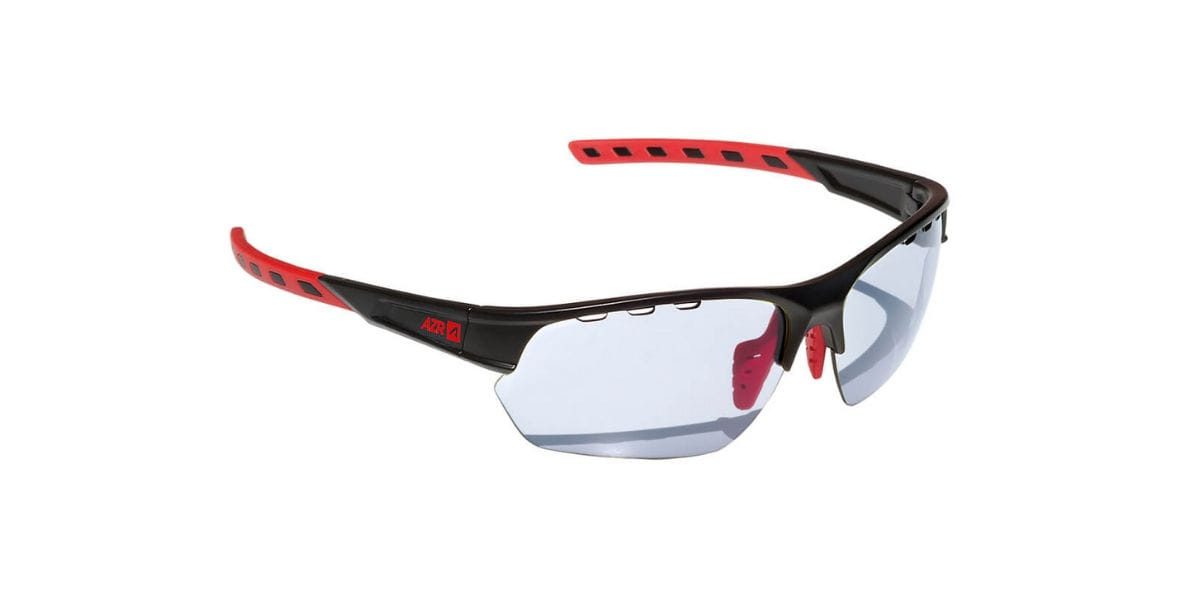
Finally, AZR's price positioning makes it a player in products with a very attractive value for money.
As is often the case in the cycling world, 90% of the products are for men ... Women's glasses exist, but the range is very limited. Please note that there is no other difference other than the color and width of the frame. So mens cycling glasses = womens cycling glasses.
Rudy Project: an unbreakable guarantee 🔨!
Rudy Project is an Italian brand that has been around since 1985. Focusing in particular on sunglasses, they base their market position on innovation and constant user feedback to improve their products.
A carbon frame with Impactx Photochromic 2 Red lenses is recommended for mountain biking.
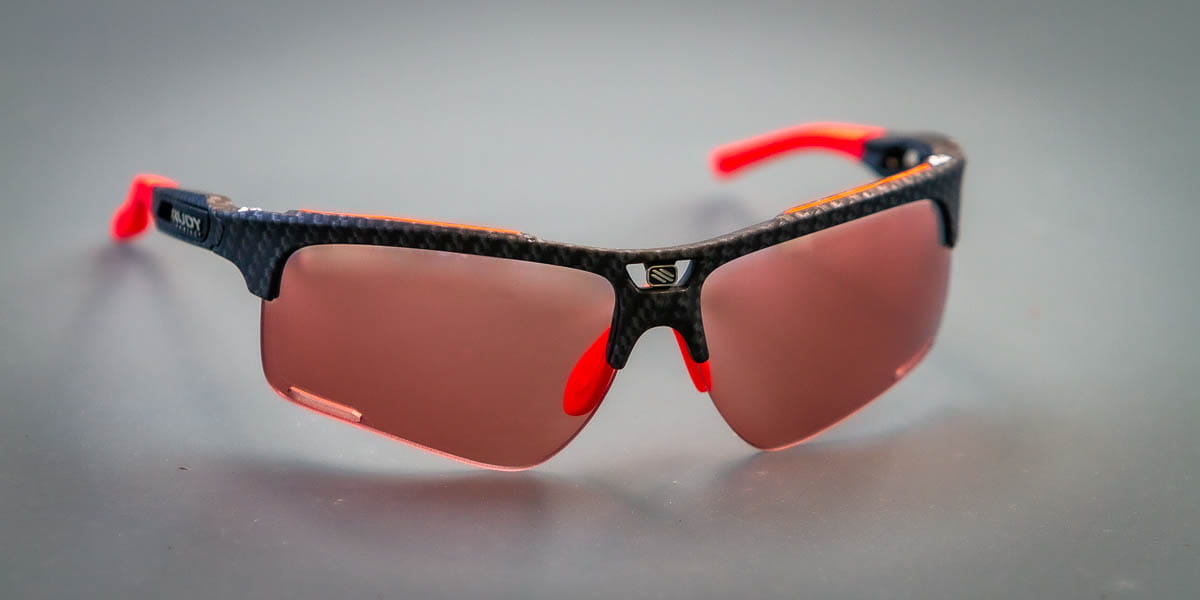
The glasses are guaranteed to be shatterproof for life. Their semi-rigid structure provides lower chromatic dispersion than polycarbonate for crisp images and good visual comfort. The manufacturer reports an HDR filter to increase contrast without changing colors, the effect is relatively limited in use. Photochromic properties are good when dyed quickly in seconds.
The glasses are lightweight and adaptable, with side arms and nasal support, this allows small faces, such as children and women, to perfectly adjust the frame. The comfort is good, the eye is well protected, the field of view is wide.
The Rudy Project has developed a very efficient airflow system with integrated tailpipes at the top of the frame. No fog disturbs the practitioner during use, but on the other hand, airflow is too important at speeds above 20 km / h.
Cycling goggles are supplied in a very durable design plastic box.
Finally, the aesthetics allow them to be used mainly outdoors: they look sporty everywhere, which cannot be said for other manufacturers offering wider face glasses.
CAIRN: Branches Refinement
Well established in winter sports protection, CAIRN entered the cycling market in 2019.
The French brand, located near Lyon, instead first turned to a line of bicycle helmets, continuing their ski helmet expertise and then diversifying.
The brand's photochromic lenses are categorized from 1 to 3. Their shade quickly adapts to light levels.
CAIRN offers several models of goggles that can be used for mountain biking, notably Trax and Downhill.
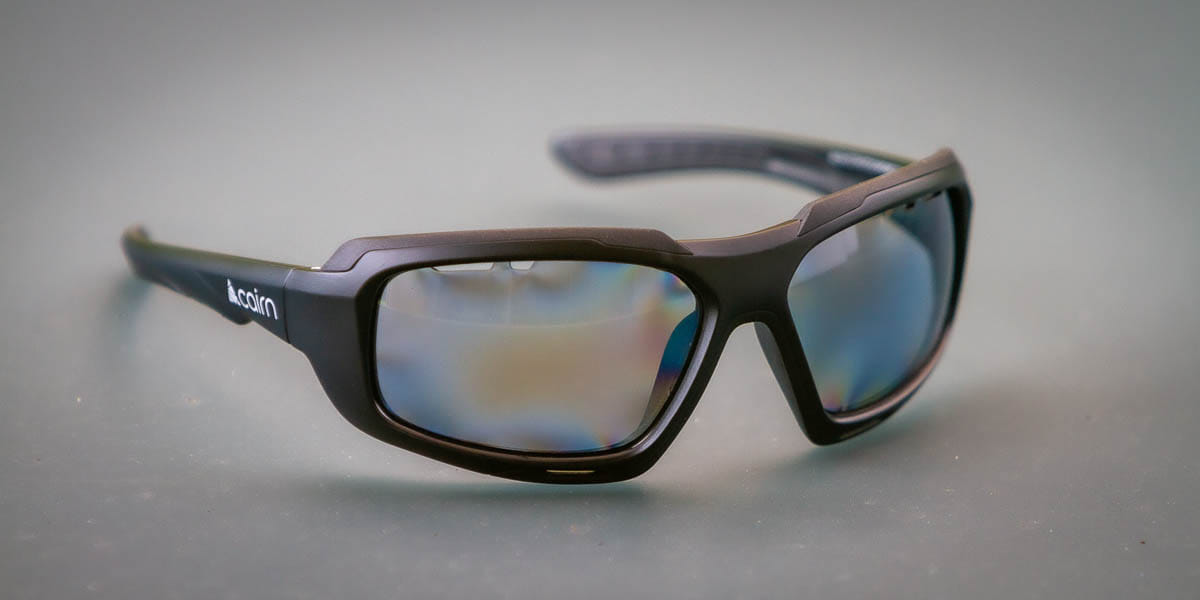
Trax has ventilation on the front, integrated into the frame, and on the top of the lenses to prevent fogging: moisture generated during training is removed thanks to this optimized airflow. The shape is covered with curved branches for excellent protection from falling sunlight.
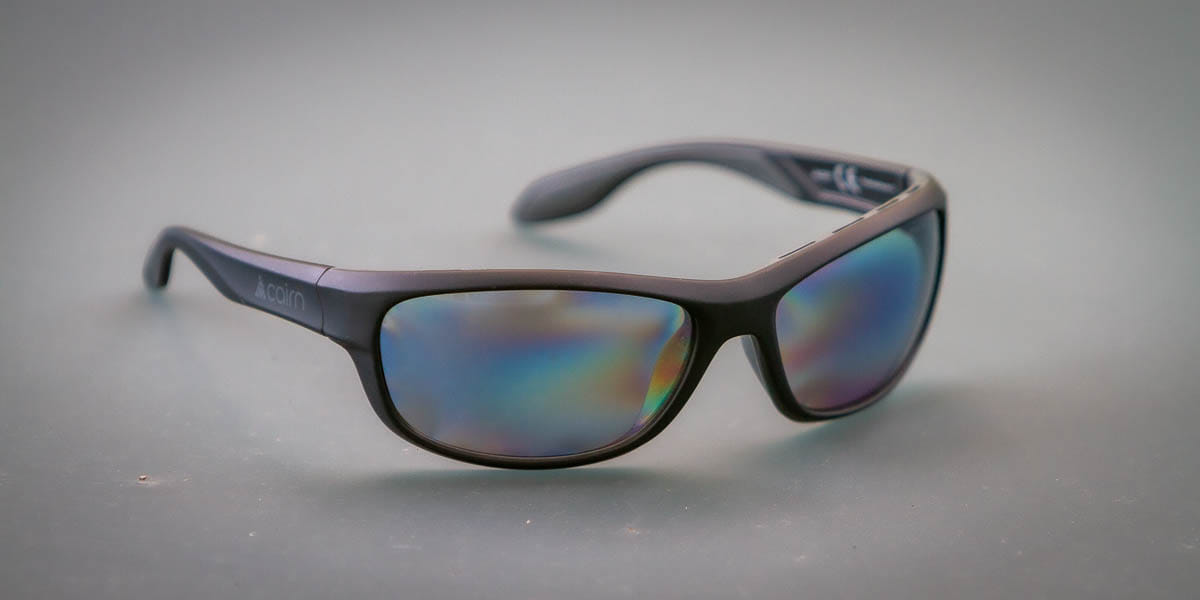
Designed for mountain biking, the downhill goggles are lightweight with thin temples to keep out of the way under the helmet. The frame is wrapped to avoid the discomfort of slanting spokes and to protect airflow. It has a built-in support handle on the inside of the frame, on the nose and temples to stay in place despite the high speed of the jerks. They are comfortable to wear, but on a rainy day, we caught them off guard in the fog.
We loved the TRAX frame, which has a rather classic outdoor design but is very effective in terms of protection. Plus, it is being sold at a very affordable price for that level of quality 👍.
UVEX: The Pros of Professional Protection
The German company UVEX, a brand that has been in the field of professional protection for decades, has turned to protective gear in sports with a specialized subsidiary: Uvex-sports.
The manufacturer's know-how in terms of comfort and protection cannot be surpassed as UVEX manufactures eyewear for (almost) all types of situations. Photochromic technology is called variomatic and allows you to vary the shades between 1 and 3 categories.
The Sportstyle 804 V is offered by UVEX for mountain biking with variomatic technology.
With a large panoramic curved screen, the protection against light rays is good. The lenses are tinted in less than 30 seconds and the UV protection is 100%. Their cycling goggles do not have an all-encompassing frame, so the field of view is not limited. This means that the wind protection is slightly lighter than on other models / frames, but ventilation is better and very effective against fogging (the lenses are also treated against fogging). The temples and nose pads are covered with rubber pads that can be adjusted for optimal support.
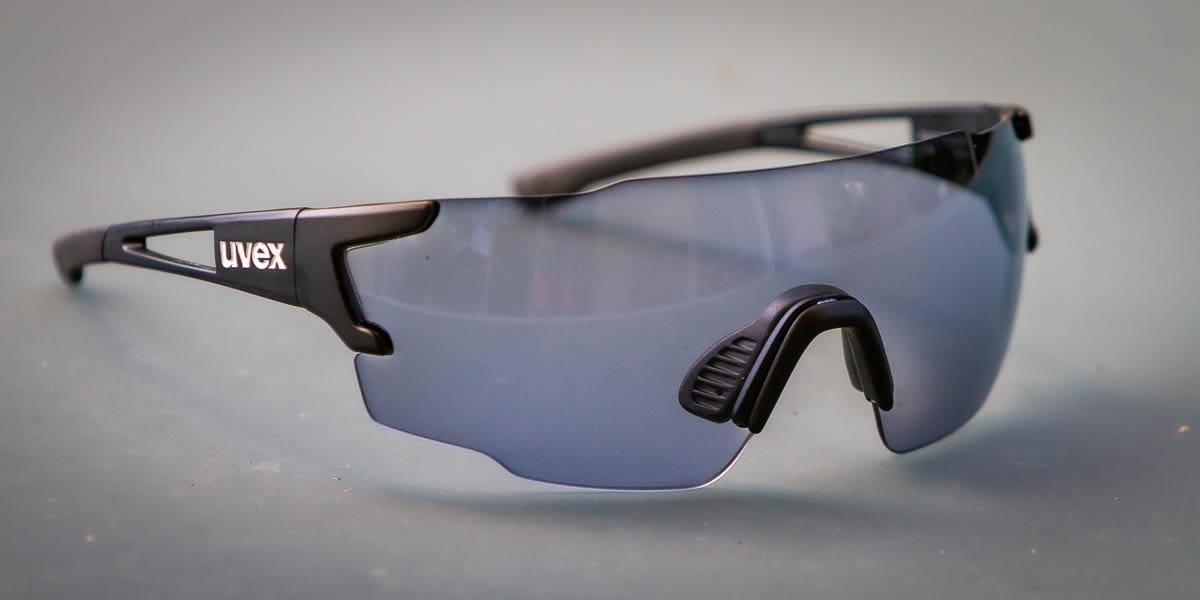
Bollé: Chronoshield and Phantom goggles
Bollé, founded at the end of the 19th century in the melting pot of eyewear manufacturers in Ain, Oyonnax, specializes in sports eyewear.
The Chronoshield cycling eyewear model is one of the brand's flagship models. It has been in existence since 1986! Equipped with red-brown "Phantom" photochromic lenses, they respond perfectly to changes in light and fluctuate between categories 2 and 3, emphasizing contrasts. The frames are very comfortable to wear thanks to adjustable nose pads and flexible temples that can be molded to the shape of the face. As a result, the frame does not move and remains very stable even on very rough roads. The mask is very large, it provides optimal protection from light and wind, it is one of the best protections on the market. The lenses have holes at the top and bottom to allow air to pass through and prevent fogging, which is very effective when used. However, at very high speeds, you can still feel the wind in your eyes. To reduce this impression, as well as to prevent sweat from getting on the lenses, the goggles come with a guard that is inserted into the top of the goggles in an arcuate fashion.
Add to that very well-crafted packaging and the ability to wear prescription lenses, this is a particularly attractive product for mountain biking.
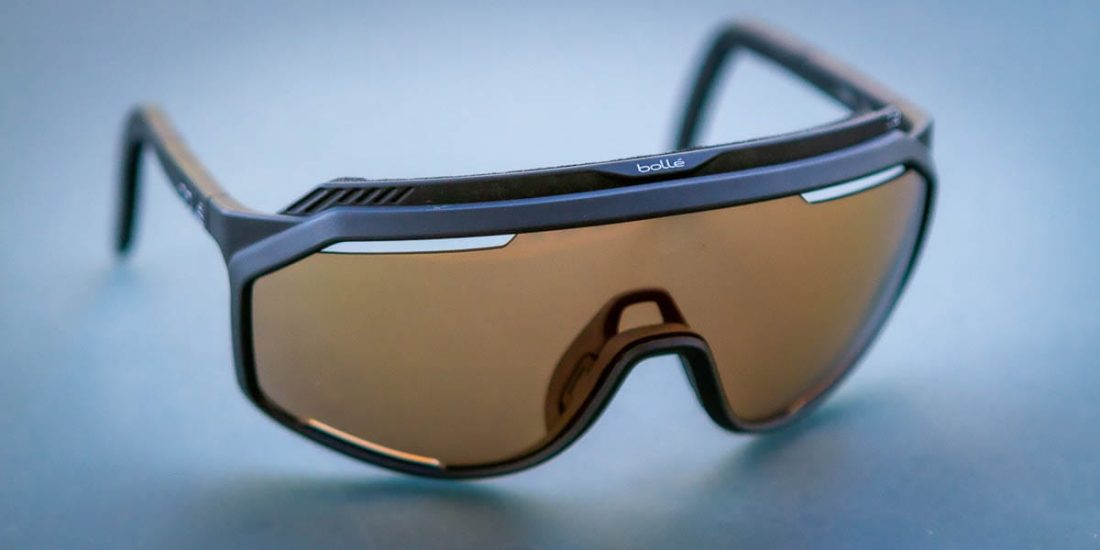
What are the alternatives to photochromic lenses?
Not all brands offer photochromic lens products, and some have opted for other technologies that are also good for mountain biking.
In particular, this applies to POC with Clarity and Oakley with Prizm. Two lens technologies from these brands.
POC: loyal style
POC started out in skiing and quickly established itself as a premium mountain bike safety accessories manufacturer. Sunglasses are no exception to the Swedish brand's reputation for offering simple and stylish designs.
POC has developed Clarity lenses in collaboration with Carl Zeiss Vision, a manufacturer well known for the quality of their optics in the photography world, to provide adequate protection while maintaining adequate light speed and contrast in all situations. ...
We tested the CRAVE and ASPIRE models, both with category 2 bronze tinted lenses. The lenses are interchangeable and can be purchased separately to fit depending on use (mountain bike vs. road bike) or weather conditions.
The POC style is dedicated to its craft, it will definitely not leave you indifferent, but the benefits are obvious: the field of view is very wide, optimal and without distortion. Panoramic view! The glasses are lightweight and comfortable. They do not put painful pressure on the temples or nose. They stay in place without slipping. Air circulation and air flow protection are excellent (the most sensitive to the slightest draft in front of our eyes will be satisfied, the protection is optimal); Category 2 lenses behave very well when passing through the undergrowth and therefore changing brightness; sharpness and contrast are well maintained;
Only downside: Provide a microfiber cloth, a few drops of sweat may drip, and rubbing will leave marks.
Preference for the ASPIRE model, which brings the concept of ski goggles to the world of cycling: a very large, very large screen that gives a feeling of safety and excellent overall protection, improving visibility. In terms of size, this model is not easy to wear anywhere other than cycling, but the protection is perfect and the quality of the lenses used by POC is excellent.
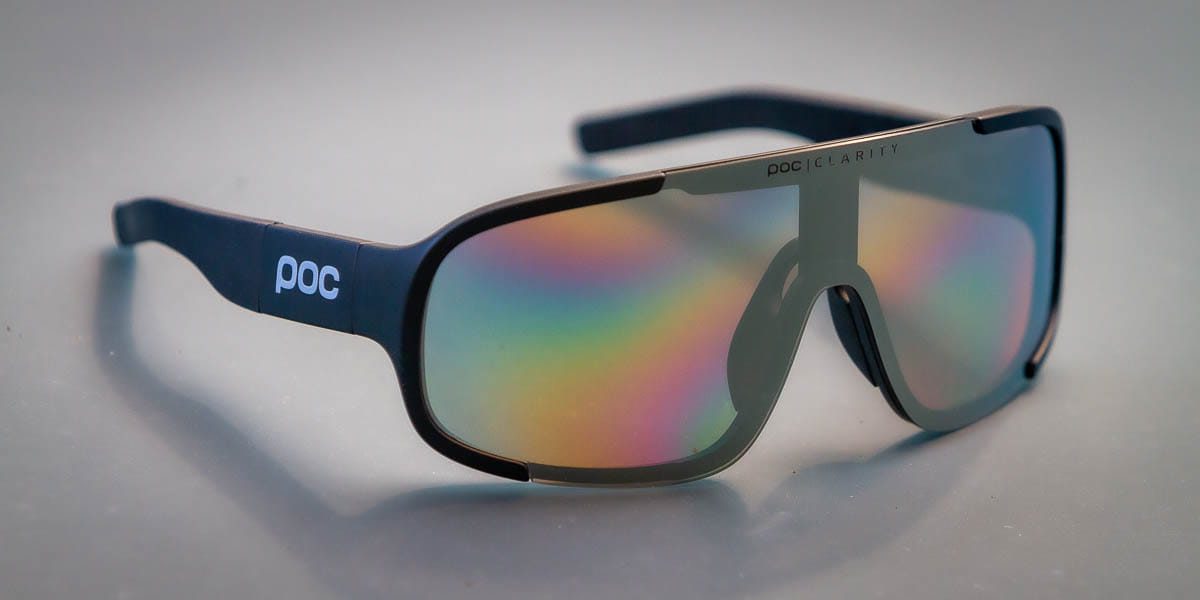
Oakley: PRIZM it's clear
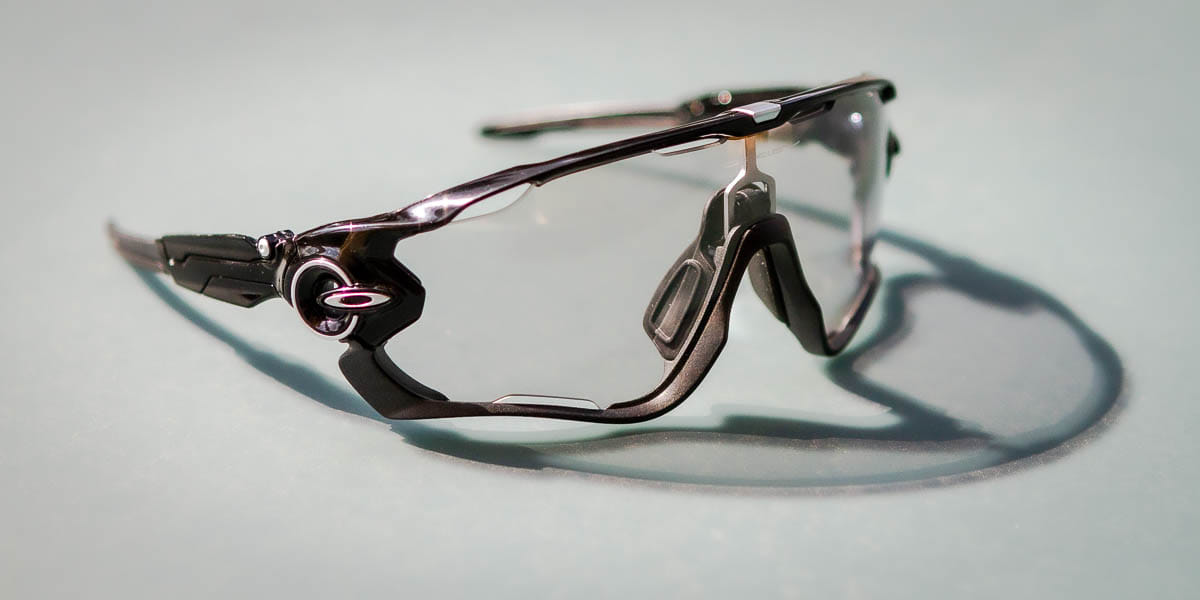
While the catalog features photochromic products such as the JawBreaker frame, which is fitted with Category 0 to Category 2 photochromic lenses (ideal for day walks where you can shoot at night), the Californian brand prefers to focus its communications on PRIZM. lens technology.
Oakley's PRIZM lenses precisely filter light and saturate colors. In this way, colors are adjusted to optimize contrast and improve visibility.
Mountain biking outdoor FLAK 2.0 goggles with lenses Torch trail recommended
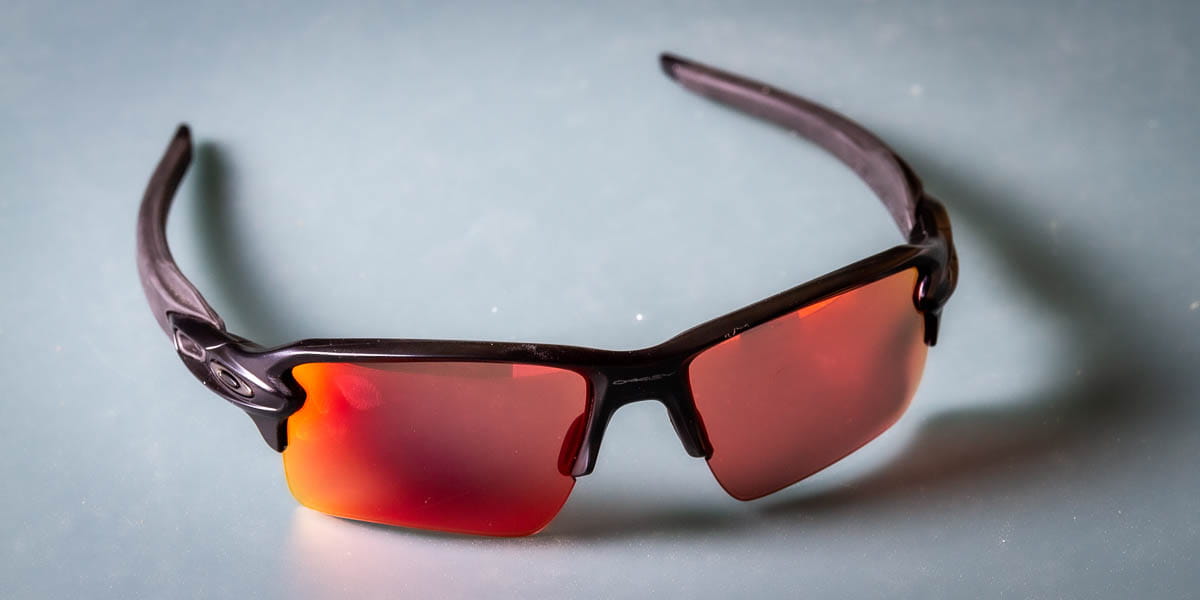
In terms of optics, the Prizm Trail Torch screen provides better visibility on trails, especially in the forest, by improving vividness of colors, contrast and depth perception (very practical for roots and trees). Low contrast).
The base color is pink with an iridium mirror exterior, giving the glass a beautiful red color.
The situation is really good! The glasses are voluminous and do not make themselves felt. The frame is lightweight and durable, and the curvature of the lens expands peripheral vision while providing a coating that improves lateral protection from sun and air currents. The temples are equipped with durable material grips and are perfectly supported.
Oakley is in the high-end segment and offers a very high-quality product that underscores the brand's seriousness with regard to sports eyewear and, in particular, motorcycles.
Naked Optics: glasses and mask
A young Austrian brand, founded in 2013, offers very high quality finished products designed for mountain biking. There are no photochromic lenses in the catalog, but there are polarized lenses with increased contrast. The strength of the brand in the mountain biking area remains the HAWK model with a price-performance ratio and unique modularity of the frames: strength and flexibility of the branches (made of "eco-friendly" plastic), adjustable support on the nose, anti-foam Magnetic sweat in the upper part of the frame and, above all, the possibility change goggles and turn goggles into a skiing (or skiing) mask.
Although we are using a "screen" model, the width of the bezel allows it to be adapted to small faces, which is especially convenient for women, or for use under a full face helmet in gravity mode.

What if you need an acute optical correction?
Not everyone is lucky enough to have good eyesight, and sometimes it is necessary to turn to models or brands that offer optical correction. It is possible, but it is done by professionals who, like traditional glasses, order lenses adapted to the correction, to the frame, with the appropriate sun treatment (for example, in the case of Julbo).
SOLUTION for people over forty 👨🦳 with presbyopia
To easily read data from the GPS screen or cardiac clock, you can attach the bifocal silicone adhesive reading lenses to the inside of your sunglasses. (Like here or there).
Feel free to resize the lenses with a cutter to make them fit perfectly with your mountain bike goggles, and wait 24 hours before using them for the first time. Then everything will become less blurry again! 😊
Conclusion
Many people do not want to raise the price of mountain bike goggles because they often lose them ... But why do they lose them? Because they are taking them! 🙄
Why are they deleting them? Because they interfere with them: comfort, brightness, fog, etc.
With a good pair of photochromic cycling goggles, there's no reason to take them off anymore, as the lenses change color depending on the light. Admittedly, the investment is not low, but the only risk remains - to break them when falling ... and a priori, fortunately, this does not happen every day!

